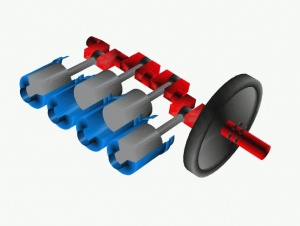Difference between revisions of "Crankshaft"
(Created page with " <!-- Start of Comments this information is to help the person collaborating on the Wiki Page Terminology Template Copy all of the information on this page and paste it ont...") |
|||
| (4 intermediate revisions by the same user not shown) | |||
| Line 10: | Line 10: | ||
{{Template:Openx}} <!-- Do not remove this line --> | {{Template:Openx}} <!-- Do not remove this line --> | ||
| + | [[Image:Cshaft.jpg|300px|thumb|Crankshaft (red), pistons (gray) in their cylinders (blue), and flywheel (black)]] | ||
| + | ==Definition== | ||
| + | |||
| + | The '''crankshaft''', sometimes abbreviated to ''[[crank (mechanism)|crank]]'', is the part of an [[engine]] that translates [[reciprocation|reciprocating]] [[linear]] [[piston]] motion into rotation. To convert the reciprocating motion into rotation, the crankshaft has "crank throws" or "[[crankpin]]s", additional bearing surfaces whose axis is offset from that of the crank, to which the "big ends" of the [[connecting rod]]s from each cylinder attach. | ||
| + | |||
| + | It is typically connected to a [[flywheel]] to reduce the pulsation characteristic of the [[four-stroke cycle]], and sometimes a torsional or vibrational damper at the opposite end, to reduce the [[torsional vibration]]s often caused along the length of the crankshaft by the cylinders farthest from the output end acting on the torsional elasticity of the metal. | ||
| − | |||
| Line 18: | Line 23: | ||
== [[References]] == | == [[References]] == | ||
| + | |||
| + | * [http://en.wikipedia.org/wiki/Crankshaft Wikipedia] | ||
Latest revision as of 14:17, 1 April 2020
Definition
The crankshaft, sometimes abbreviated to crank, is the part of an engine that translates reciprocating linear piston motion into rotation. To convert the reciprocating motion into rotation, the crankshaft has "crank throws" or "crankpins", additional bearing surfaces whose axis is offset from that of the crank, to which the "big ends" of the connecting rods from each cylinder attach.
It is typically connected to a flywheel to reduce the pulsation characteristic of the four-stroke cycle, and sometimes a torsional or vibrational damper at the opposite end, to reduce the torsional vibrations often caused along the length of the crankshaft by the cylinders farthest from the output end acting on the torsional elasticity of the metal.
Random Page | Longest Wikis | Oldest Wikis | Newest Images | Newest Wikis | List of Categories | List of Every Freakin Wiki
- Register to Edit
- It takes less than 5 minutes to request registration for editing, and we try to approve within 24 hours. Click the Register Link in the Top Bar.
- MoparWiki Help
- While editing Wikis may at first glance appear a little overwhelming, it really isn't. You will find this site's HELP (link found in the sidebar) to be very strong and easy to understand. The best way to start is with small edits and working on your user page -- and you will become a Pro in no time.

